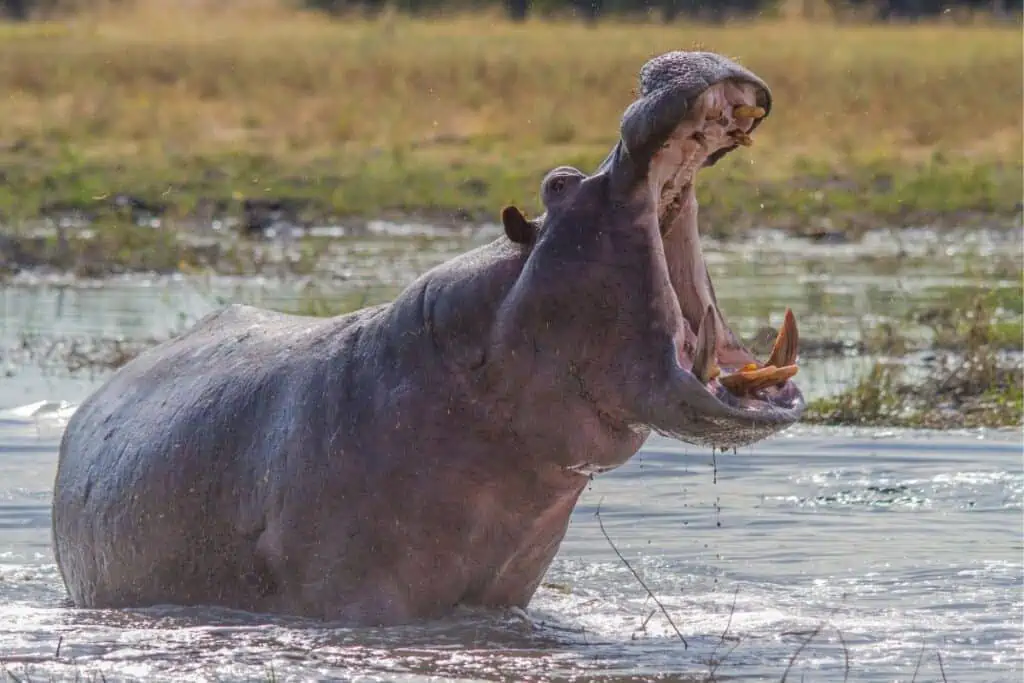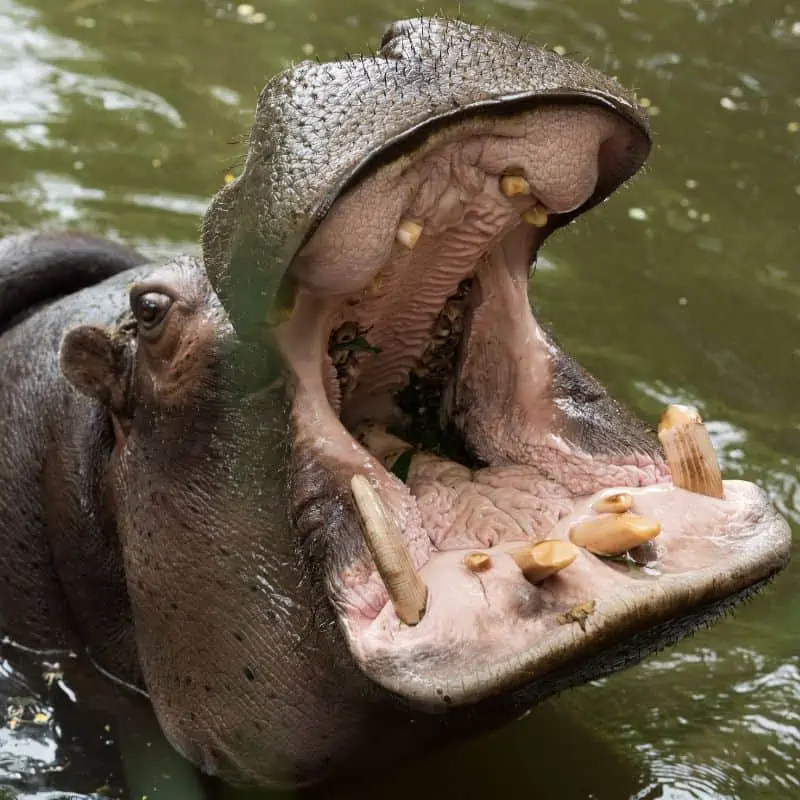Hippos are extraordinary semi-aquatic creatures that you only seem to see in captivity. That’s because of habitat loss, which makes their endangered status vulnerable.
You may notice a hippo’s extraordinary mouth if you see them at the zoo or in the wild. As it happens, these mouths are home to one of the strongest teeth in the animal world, with a bit of historical relevance.
Let’s look into what makes hippo teeth so special.

Top 7 Hippo Teeth Facts
One of the most distinctive features of hippos is their large, protruding teeth. Here are seven facts that you may not know:
1. Hippos Have 36 Teeth on Average
A fully-grown hippo has 36 teeth. Yet, some may reach up to 38 to 44 in other cases. That’s because some of their deciduous teeth stay even after growing their permanent set. Adult hippos could eventually lose them, but some don’t.
Like our own teeth, hippos’ mouths have four quadrants: molars, premolars, canines, and incisors. Most of these teeth are their molars and premolars, which account for 28 of them.
You’ll see their canines and incisors in the front of their mouth. The hippos’ incisors are also commonly called tusks. These hefty tusks are the most visible when hippos open their mouths wide, so they get all the fame.
2. Hippo Teeth Are Substitute for Elephant Ivory
Many hunters and poachers consider hippo teeth valuable since they get sold in the market as substitutes for elephant ivory in the carving industry.
You can uncover ivory when removing the enamel from hippos’ teeth. They’re a cheaper alternative to the illegal and more luxurious elephant ivory. Plus, they tend to keep their original color even as they age.
Another reason they make a suitable substitute is because they’re easier to smuggle. Unfortunately, their ranking in the international protection against the ivory trade isn’t as high as that of elephants. As a result, many people continue to exploit the hippos’ canines and incisors.
That said, hippo ivory is still legal in many African countries, such as Malawi, Zambia, and Zimbabwe. It’s because that’s where most of the poaching practices come from. Hong Kong imports the majority of the hippo ivory hunted globally.

3. Hippo Ivory Was Used in Dentures
Believe it or not, there was a time when ivory from hippo teeth was a part of human dentures, especially during the 18th century. During that time, only wealthy people could afford to have ivory in their mouths.
The main problem with ivory dentures was that they weren’t very comfortable to wear. Not only that, but they were also tricky to clean.
So, although they were considered highly luxurious back then, dentures made from ivory deteriorated fast and often smelled unpleasant.
The 1st American president, George Washington, reportedly had dentures made from hippo ivory and metal.
4. A Hippo Bite Can Cut a Human in Half
Contrary to what you see in cartoon drawings, hippos don’t have blunt tusks. That’s just because most zookeepers choose to cut and trim them for easier handling.
In reality, hippos’ teeth are razor-sharp. Plus, their enormous mouths, in combination with their strong jaws, give them a biting force of a whopping 1,800 PSI. That’s more powerful than that of polar bears, jaguars, or gorillas.
Maybe we got lucky that they’re herbivores since they could damage a human’s body if necessary. After all, they’re one of the most dangerous animals for a good reason.
Hippos have a record of wiping out 500 people every year in Africa.
That said, they only attack when they sense danger. So, you’ll probably be safe around a group of hippos if you don’t provoke them.
5. Hippo Teeth Don’t Chew Meat
As a herbivore, you’d expect a hippo to have the same dental structure as other common herbivorous animals.
However, hippos don’t have flat teeth to crush leaves and plants, unlike cattle and horses. Instead, they have cheek teeth made up of molars and premolars. These sets of teeth grind about 50 pounds of food every day.
Hippos use their large canines and incisors mainly for predators. The interesting thing about this is that hippos get to sharpen these teeth when chewing. So, they may not help grinding food, but they’re extremely sharp, which is perfect for deterring enemies.

6. Hippo Teeth Don’t Stop Growing
It might sound fiction, but a hippo’s front teeth don’t stop growing. Their front teeth can reach up to 20 inches (51 cm).
Male hippos generally have larger teeth than females.
Not only because it matches their heftier bodies as part of natural selection but also because they tend to use it for dominance against other male hippos.
7. Hippos Have Personal Dentists
Hippos typically submerge themselves in rivers or lakes for up to 16 hours. That’s because they need to keep their bodies cool during the day, but it turns out that there’s even more in it for them.
When hippos are underwater, fish like barbels eat the parasites off of their body. Sometimes hippos will open their mouths for the fish to nibble on the dirt in their teeth.
Oxpeckers also devour dead skin from hippos’ backs, ears, nostrils, and mouth corners when hippos are on land.
Final thoughts on hippo teeth
Hippos are interesting creatures with large teeth that grow continuously throughout their lives.
Their teeth are surprisingly sharp, even though they are herbivores. The ivory from their teeth is highly valuable, which has led to hippos being hunted for their tusks.
These big animals play an important role in the ecosystem and must be protected.

